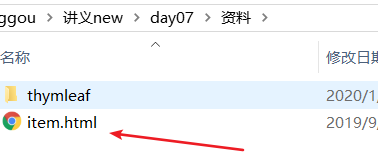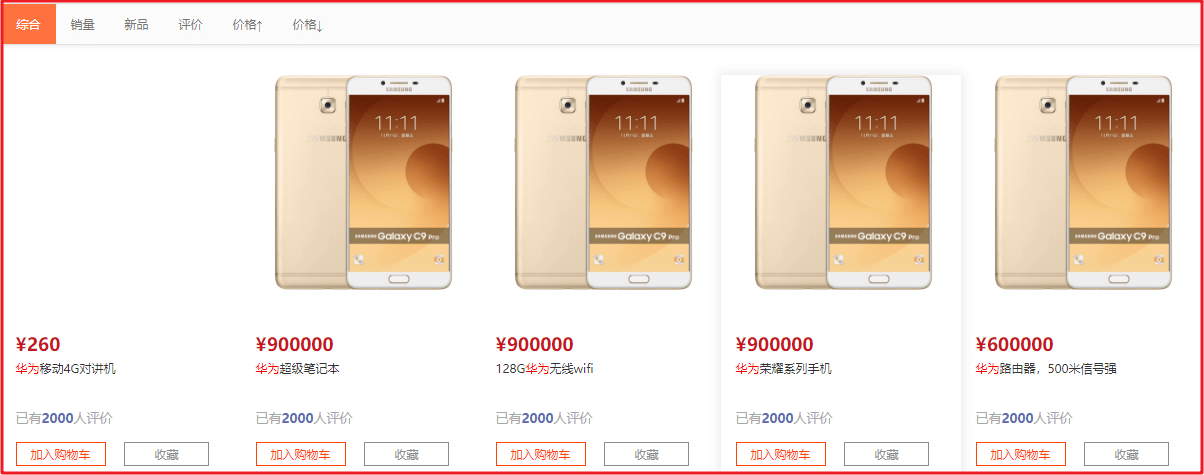学习目标
- Thymeleaf的介绍
- Thymeleaf的入门
- Thymeleaf的语法及标签
- 商品详情页静态化工程搭建
商品详情页静态化功能实现
1.详情页静态化操作2.填充基础数据 Spu、List<Sku>3.规格切换
搜索页面渲染
1.数据展示2.搜索条件展示3.实现条件搜索控制
-
1.Thymeleaf介绍
thymeleaf是一个XML/XHTML/HTML5模板引擎,可用于Web与非Web环境中的应用开发。它是一个开源的Java库,基于Apache License 2.0许可,由Daniel Fernández创建,该作者还是Java加密库Jasypt的作者。
Thymeleaf提供了一个用于整合Spring MVC的可选模块,在应用开发中,你可以使用Thymeleaf来完全代替JSP或其他模板引擎,如Velocity、FreeMarker等。Thymeleaf的主要目标在于提供一种可被浏览器正确显示的、格式良好的模板创建方式,因此也可以用作静态建模。你可以使用它创建经过验证的XML与HTML模板。相对于编写逻辑或代码,开发者只需将标签属性添加到模板中即可。接下来,这些标签属性就会在DOM(文档对象模型)上执行预先制定好的逻辑。
它的特点便是:开箱即用,Thymeleaf允许您处理六种模板,每种模板称为模板模式: XML
- 有效的XML
- XHTML
- 有效的XHTML
- HTML5
- 旧版HTML5
所有这些模式都指的是格式良好的XML文件,但Legacy HTML5模式除外,它允许您处理HTML5文件,其中包含独立(非关闭)标记,没有值的标记属性或不在引号之间写入的标记属性。为了在这种特定模式下处理文件,Thymeleaf将首先执行转换,将您的文件转换为格式良好的XML文件,这些文件仍然是完全有效的HTML5(实际上是创建HTML5代码的推荐方法)1。
另请注意,验证仅适用于XML和XHTML模板。
然而,这些并不是Thymeleaf可以处理的唯一模板类型,并且用户始终能够通过指定在此模式下解析模板的方法和编写结果的方式来定义他/她自己的模式。这样,任何可以建模为DOM树(无论是否为XML)的东西都可以被Thymeleaf有效地作为模板处理。
2.Springboot整合thymeleaf
使用springboot 来集成使用Thymeleaf可以大大减少单纯使用thymleaf的代码量,所以我们接下来使用springboot集成使用thymeleaf.
实现的步骤为:
- 创建一个sprinboot项目
- 添加thymeleaf的起步依赖
- 添加spring web的起步依赖
- 编写html 使用thymleaf的语法获取变量对应后台传递的值
- 编写controller 设置变量的值到model中
(1)创建工程
创建一个独立的工程springboot-thymeleaf,该工程为案例工程,不需要放到changgou-parent工程中。
pom.xml依赖
<?xml version="1.0" encoding="UTF-8"?><project xmlns="http://maven.apache.org/POM/4.0.0"xmlns:xsi="http://www.w3.org/2001/XMLSchema-instance"xsi:schemaLocation="http://maven.apache.org/POM/4.0.0 http://maven.apache.org/xsd/maven-4.0.0.xsd"><modelVersion>4.0.0</modelVersion><groupId>com.itheima</groupId><artifactId>springboot-thymeleaf</artifactId><version>1.0-SNAPSHOT</version><parent><groupId>org.springframework.boot</groupId><artifactId>spring-boot-starter-parent</artifactId><version>2.1.4.RELEASE</version></parent><dependencies><!--web起步依赖--><dependency><groupId>org.springframework.boot</groupId><artifactId>spring-boot-starter-web</artifactId></dependency><!--thymeleaf配置--><dependency><groupId>org.springframework.boot</groupId><artifactId>spring-boot-starter-thymeleaf</artifactId></dependency></dependencies></project>
(2)创建html
在resources中创建templates目录,在templates目录创建 demo1.html,代码如下:
<!DOCTYPE html><html xmlns:th="http://www.thymeleaf.org"><head><title>Thymeleaf的入门</title><meta http-equiv="Content-Type" content="text/html; charset=UTF-8"/></head><body><!--输出hello数据--><p th:text="${hello}"></p></body></html>
解释:<html xmlns:th="http://www.thymeleaf.org">:这句声明使用thymeleaf标签<p th:text="${hello}"></p>:这句使用 th:text=”${变量名}” 表示 使用thymeleaf获取文本数据,类似于EL表达式。
(3)修改application.yml配置
创建application.yml,并设置thymeleaf的缓存设置,设置为false。默认加缓存的,用于测试。
spring:thymeleaf:cache: false
在这里,其实还有一些默认配置,比如视图前缀:classpath:/templates/,视图后缀:.htmlorg.springframework.boot.autoconfigure.thymeleaf.ThymeleafProperties部分源码如下: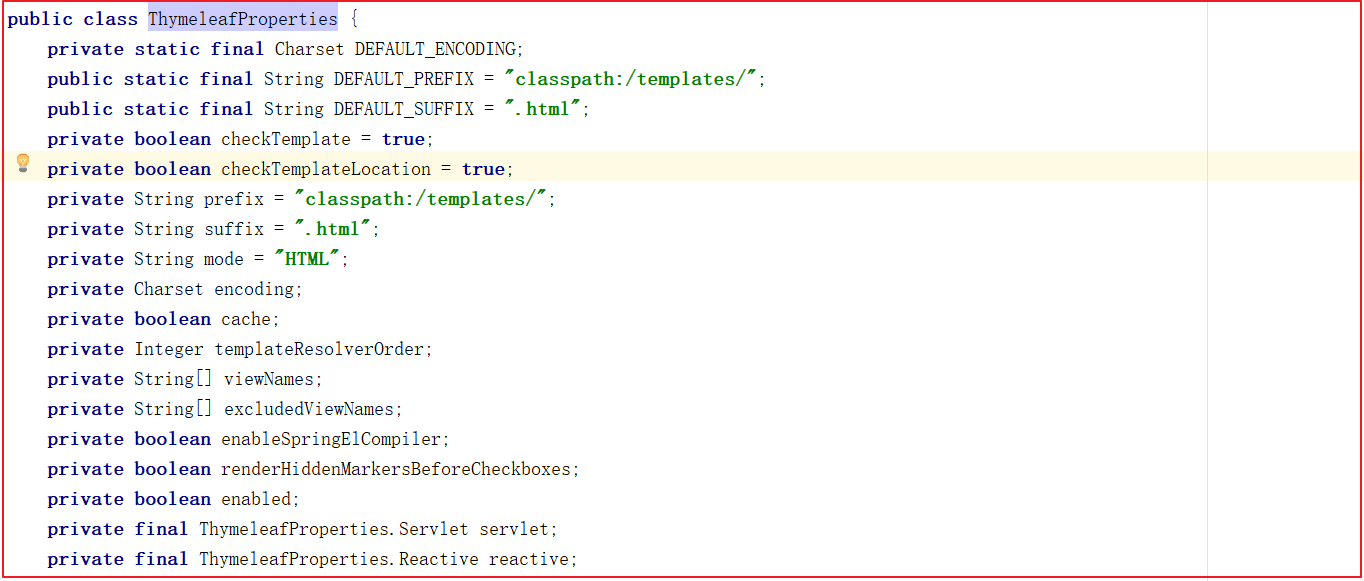
(4)控制层
创建controller用于测试后台 设置数据到model中。
创建com.itheima.controller.TestController,代码如下:
@Controller@RequestMapping("/test")public class TestController {/**** 访问/test/hello 跳转到demo1页面* @param model* @return*/@RequestMapping("/hello")public String hello(Model model){model.addAttribute("hello","hello welcome");return "demo1";}}
(5)测试
创建启动类com.itheima.ThymeleafApplication,代码如下:
@SpringBootApplicationpublic class ThymeleafApplication {public static void main(String[] args) {SpringApplication.run(ThymeleafApplication.class,args);}}
启动系统,并在浏览器访问
http://localhost:8080/test/hello
3 Thymeleaf基本语法
(1)th:href 后台代码
model.addAttribute("key1","value1");model.addAttribute("url","/test/hello");
html:
<a th:href="@{${url}(key1=${key1},key2=${key1})}">去黑马网站首页</a>
(2)th:each 遍历,功能类似jstl中的<c:forEach>标签。
创建com.itheima.model.User,代码如下:
public class User {private Integer id;private String name;private String address;//..get..set}
Controller添加数据,List输出
/**** 访问/test/hello 跳转到demo1页面* @param model* @return*/@RequestMapping("/hello")public String hello(Model model){model.addAttribute("hello","hello welcome");//集合数据List<User> users = new ArrayList<User>();users.add(new User(1,"张三","深圳"));users.add(new User(2,"李四","北京"));users.add(new User(3,"王五","武汉"));model.addAttribute("users",users);return "demo1";}
页面输出
<table><tr><td>id</td><td>姓名</td><td>地址</td><td>下标</td></tr><tr th:each="abc,mystat:${users}"><td th:text="${abc.id}"></td><td th:text="${abc.name}">zhangsan</td><td th:text="${abc.address}">深圳</td><td th:text="${mystat.index+1}">深圳</td></tr></table>
测试效果
(3)Map输出 后台添加Map
//Map定义Map<String,Object> dataMap = new HashMap<String,Object>();dataMap.put("No","123");dataMap.put("address","深圳");model.addAttribute("dataMap",dataMap);
页面输出
<div th:each="map,mapStat:${dataMap}"><div th:text="${map}"></div>key:<span th:text="${mapStat.current.key}"></span><br/>value:<span th:text="${mapStat.current.value}"></span><br/></div>
或者:
<div th:each="entry:${dataMap}"><div th:text="${entry}"></div>key:<span th:text="${entry.key}"></span><br/>value:<span th:text="${entry.value}"></span><br/></div>
测试效果
(4)数组输出 后台添加数组
//存储一个数组String[] names = {"张三","李四","王五"};model.addAttribute("names",names);
页面输出
<div th:each="nm,nmStat:${names}"><span th:text="${nmStat.count}"></span><span th:text="${nm}"></span>==============================================</div>
测试效果
(5)Date输出
后台添加日期
//日期model.addAttribute("now",new Date());
页面输出
<div><span th:text="${#dates.format(now,'yyyy-MM-dd hh:ss:mm')}"></span></div>
测试效果
(6)th:if条件
//if条件model.addAttribute("age",22);
页面输出
<div><span th:if="${(age>=18)}">终于长大了!</span></div>
测试效果
(7)使用javascript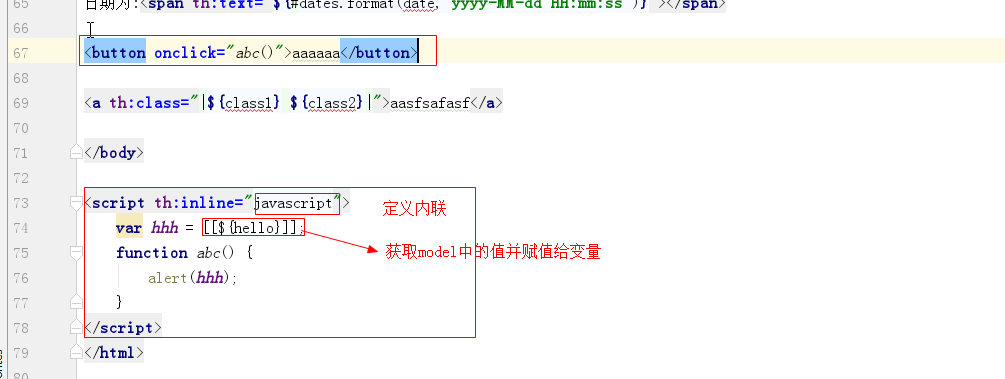
java代码为:
(8) 字符拼接 使用||
后台代码:
模板: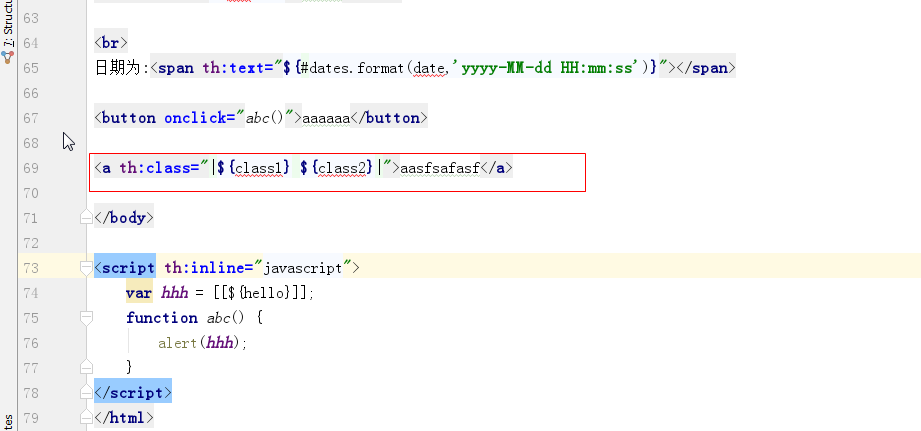
4 搜索页面渲染
4.1 搜索分析
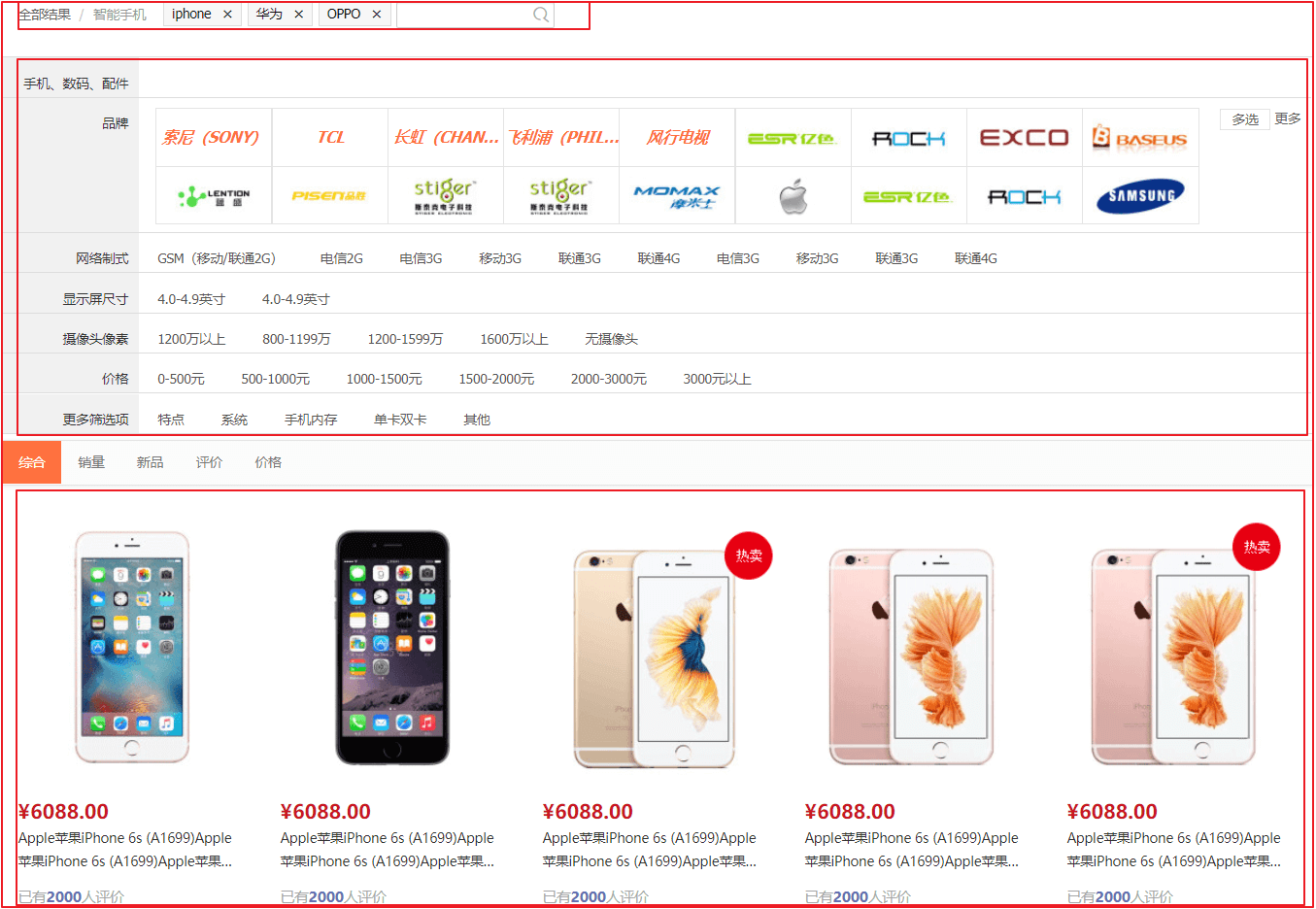
搜索页面要显示的内容主要分为3块。
1)搜索的数据结果
2)筛选出的数据搜索条件
3)用户已经勾选的数据条件
4.2 搜索实现

搜索的业务流程如上图,用户每次搜索的时候,先经过搜索业务工程,搜索业务工程调用搜索微服务工程,这里搜索业务工程单独挪出来的原因是它这里涉及到了模板渲染以及其他综合业务处理,以后很有可能会有移动端的搜索和PC端的搜索,后端渲染如果直接在搜索微服务中进行,会对微服务造成一定的侵入,不推荐这么做,推荐微服务独立,只提供服务,如果有其他页面渲染操作,可以搭建一个独立的消费工程调用微服务达到目的。
4.2.1 搜索工程搭建
(1)工程创建
在changgou-web工程中创建changgou-web-search工程,并在changgou-web的pom.xml中引入如下依赖:
<dependencies><dependency><groupId>org.springframework.boot</groupId><artifactId>spring-boot-starter-thymeleaf</artifactId></dependency><dependency><groupId>org.springframework.boot</groupId><artifactId>spring-boot-starter-web</artifactId></dependency><dependency><groupId>org.springframework.cloud</groupId><artifactId>spring-cloud-starter-netflix-eureka-client</artifactId></dependency><!--feign--><dependency><groupId>org.springframework.cloud</groupId><artifactId>spring-cloud-starter-openfeign</artifactId></dependency></dependencies>
(2)静态资源导入
将资源中的页面/前端页面/search.html拷贝到工程的resources/templates目录下,js、css等拷贝到static目录下,如下图:
(3)Feign创建
修改changgou-service-search-api,添加com.changgou.search.feign.SkuFeign,实现调用搜索,代码如下:
@FeignClient(name="search",path = "/search")//@RequestMapping("/search") == path="/search"public interface SkuFeign {@PostMappingpublic Map search(@RequestBody(required = false) Map<String, String> searchMap);}

(4)changgou-web-search的pom.xml依赖
<?xml version="1.0" encoding="UTF-8"?><project xmlns="http://maven.apache.org/POM/4.0.0"xmlns:xsi="http://www.w3.org/2001/XMLSchema-instance"xsi:schemaLocation="http://maven.apache.org/POM/4.0.0 http://maven.apache.org/xsd/maven-4.0.0.xsd"><parent><artifactId>changgou-web</artifactId><groupId>com.changgou</groupId><version>1.0-SNAPSHOT</version></parent><modelVersion>4.0.0</modelVersion><artifactId>changgou-web-search</artifactId><dependencies><!--search API依赖--><dependency><groupId>com.changgou</groupId><artifactId>changgou-service-search-api</artifactId><version>1.0-SNAPSHOT</version></dependency></dependencies></project>
(5)搜索调用,在changgou-web-search中创建com.changgou.search.controller.SkuController,实现调用搜索,代码如下:
@Controller@RequestMapping(value = "/search")public class SkuController {@Autowiredprivate SkuFeign skuFeign;/*** 搜索* @param searchMap* @return*/@GetMapping(value = "/list")public String search(@RequestParam(required = false) Map<String,String> searchMap, Model model){//调用changgou-service-search微服务Map resultMap = skuFeign.search(searchMap);model.addAttribute("result",resultMap);return "search";}}
(6)启动类创建
修改changgou-web-search,添加启动类com.changgou.SearchWebApplication,代码如下:
@SpringBootApplication@EnableEurekaClient@EnableFeignClients(basePackages = "com.changgou.search.feign")public class SearchWebApplication {public static void main(String[] args) {SpringApplication.run(SearchWebApplication.class,args);}}
(7)application.yml配置文件
server:port: 18088eureka:client:service-url:defaultZone: http://127.0.0.1:7001/eurekainstance:prefer-ip-address: truefeign:hystrix:enabled: truespring:thymeleaf:cache: falseapplication:name: search-webmain:allow-bean-definition-overriding: true
(8)项目完整结构
copy 静态资源到static下:并且修改路径:
将./ 改成 /
在search.html的头部引入thymeleaf标签
<html xmlns:th="http://www.thymeleaf.org">
测试:http://localhost:18088/search/list,效果如下: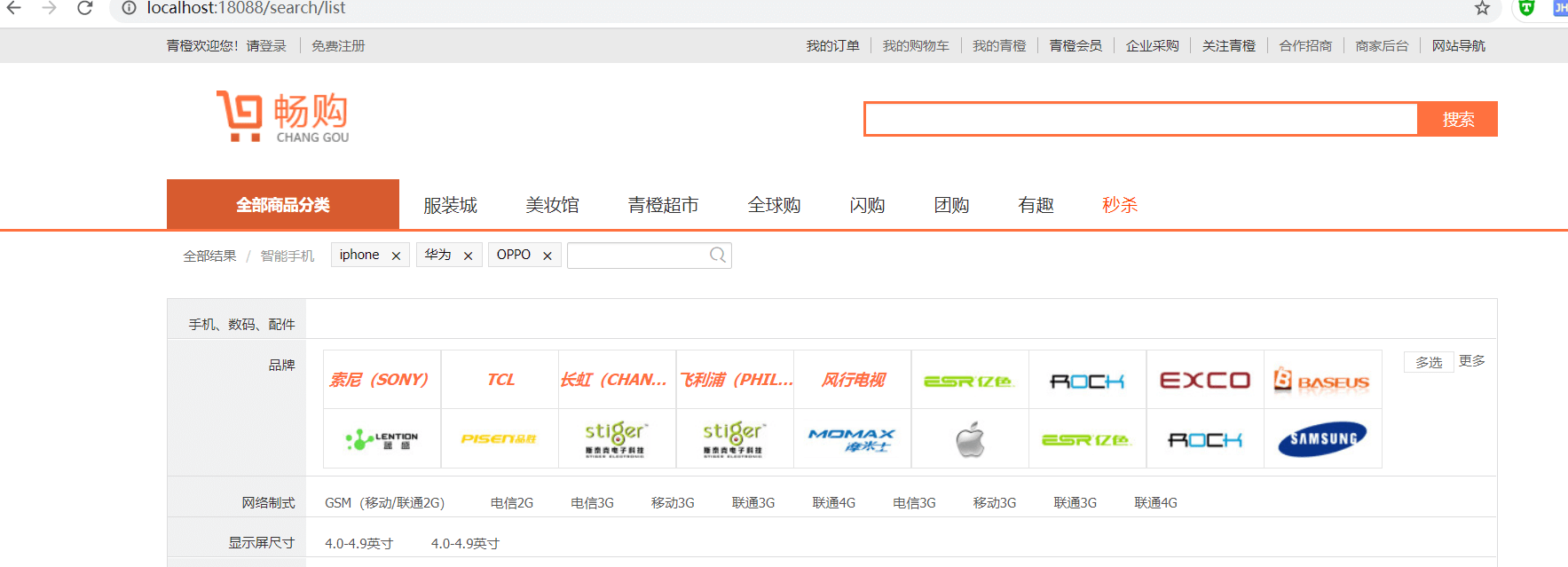
4.2.2 搜索数据填充分析
后端搜索到数据后,前端页面进行数据显示,显示的数据分为3部分
1)搜索的数据结果2)筛选出的数据搜索条件3)用户已经勾选的数据条件
4.2.3 关键字搜索
用户每次输入关键字的时候,直接根据关键字搜索,关键字搜索的数据会存储到result.rows中,页面每次根据result获取rows,然后循环输出即可,同时页面的搜索框每次需要回显搜索的关键词。
实现思路
1.前端表单提交搜索的关键词2.后端根据关键词进行搜索3.将搜索条件存储到Model中4.页面循环迭代输出数据5.搜索表单回显搜索的关键词
(1)后台搜索实现
修改SkuController的search方法,代码如下:
/*** 搜索* @param searchMap* @return*/@GetMapping(value = "/list")public String search(@RequestParam(required = false) Map<String,String> searchMap, Model model){//调用changgou-service-search微服务Map<String,Object> resultMap = skuFeign.search(searchMap);//搜索数据结果model.addAttribute("result",resultMap);//搜索条件model.addAttribute("searchMap",searchMap);return "search";}
(2)页面搜索实现修改search.html(表单修改)
注意:搜索按钮为submit提交。
(3)页面结果输出 修改search.html,代码如下:
<div class="goods-list"><ul class="yui3-g"><li class="yui3-u-1-5" th:each="sku:${result.rows}"><div class="list-wrap"><div class="p-img"><a href="item" target="_blank"><img th:src="${sku.image}" /></a></div><div class="price"><strong><em>¥</em><i th:text="${sku.price}">6088.00</i></strong></div><div class="attr"><!--js注入 html的攻击--><a target="_blank" href="item" th:utext="${sku.name}" >Apple苹果iPhone 6s (A1699)Apple苹果iPhone 6s (A1699)Apple苹果iPhone 6s (A1699)Apple苹果iPhone 6s (A1699)</a></div><div class="commit"><i class="command">已有<span>2000</span>人评价</i></div><div class="operate"><a href="success-cart" target="_blank" class="sui-btn btn-bordered btn-danger">加入购物车</a><a href="javascript:void(0);" class="sui-btn btn-bordered">收藏</a></div></div></li></ul></div>
解释:utext="${sku.name}" 获取数据 并直接解析html标签text="${sku.name}" 获取数据 只当做文本进行输出
4.3 搜索条件回显
如下图效果: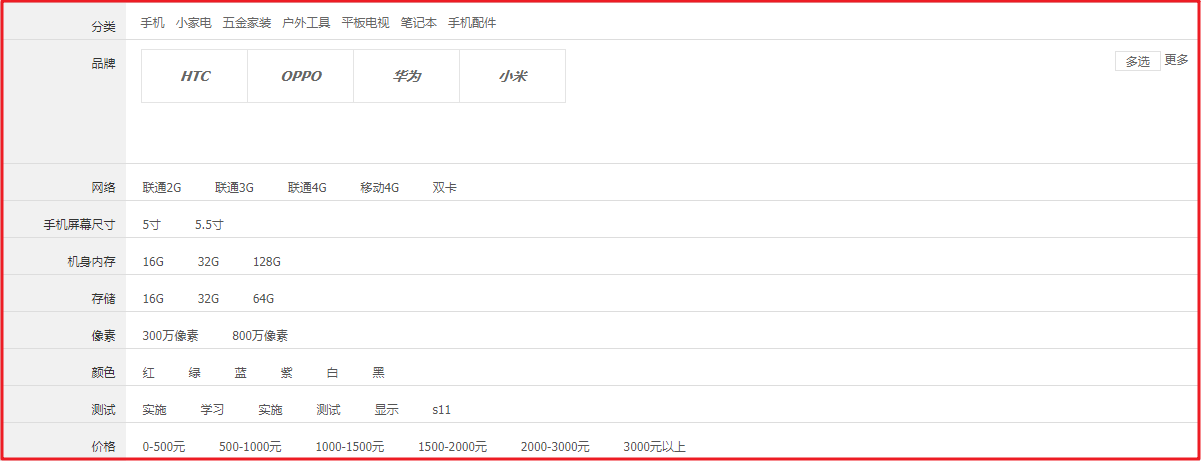
搜索条件除了关键字外,还有分类、品牌、以及规格,这些在我们前面已经将数据存入到了Map中,我们可以直接从Map中将数据取出,然后在页面输出即可。
分类:result.categoryList
品牌:result.brandList
规格:result.specMap
4.3.1 回显分类列表
修改search.html的条件显示部分:
上图代码如下:
<div class="type-wrap" th:if="not ${#maps.containsKey(searchMap,'category')}"><div class="fl key">商品分类</div><div class="fl value" th:each="category:${result.categoryList}"><a th:text="${category}" ></a></div><div class="fl ext"></div></div>
4.3.2 回显品牌列表
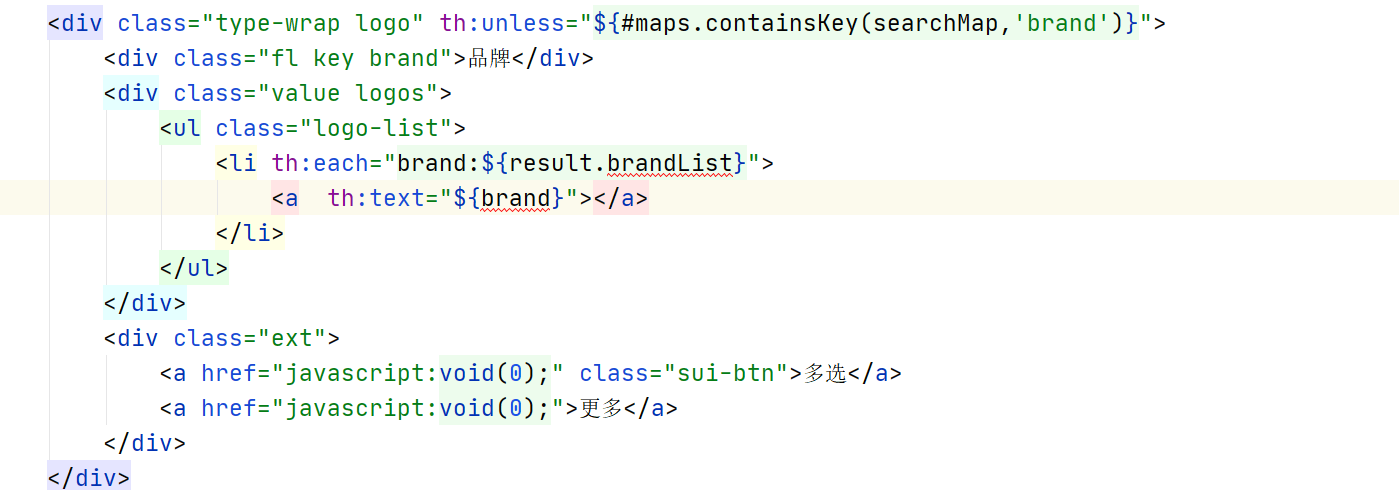
代码如下:
<div class="type-wrap logo" th:unless="${#maps.containsKey(searchMap,'brand')}"><div class="fl key brand">品牌</div><div class="value logos"><ul class="logo-list"><li th:each="brand:${result.brandList}"><a th:text="${brand}"></a></li></ul></div><div class="ext"><a href="javascript:void(0);" class="sui-btn">多选</a><a href="javascript:void(0);">更多</a></div></div>
4.3.3 回显规格列表

代码如下:
<div class="type-wrap" th:each="spec:${result.specMap}" th:if="not ${#maps.containsKey(searchMap,'spec_'+spec.key)}"><div class="fl key" th:text="${spec.key}">网络制式</div><div class="fl value"><ul class="type-list"><li th:each="op:${spec.value}"><a th:text="${op}">GSM(移动/联通2G)</a></li></ul></div><div class="fl ext"></div></div>
3个回显的整体代码如下:代码起始位置在502行左右
<div class="type-wrap" th:if="not ${#maps.containsKey(searchMap,'category')}"><div class="fl key">商品分类</div><div class="fl value" th:each="category:${result.categoryList}"><a th:text="${category}"></a></div><div class="fl ext"></div></div><div class="type-wrap logo" th:unless="${#maps.containsKey(searchMap,'brand')}"><div class="fl key brand">品牌</div><div class="value logos"><ul class="logo-list"><li th:each="brand:${result.brandList}"><a th:text="${brand}"></a></li></ul></div><div class="ext"><a href="javascript:void(0);" class="sui-btn">多选</a><a href="javascript:void(0);">更多</a></div></div><div class="type-wrap" th:each="spec:${result.specMap}" th:if="not ${#maps.containsKey(searchMap,'spec_'+spec.key)}"><div class="fl key" th:text="${spec.key}">网络制式</div><div class="fl value"><ul class="type-list"><li th:each="op:${spec.value}"><a th:text="${op}">GSM(移动/联通2G)</a></li></ul></div><div class="fl ext"></div></div>
4.4 条件搜索实现

用户每次点击搜索的时候,其实在上次搜索的基础之上加上了新的搜索条件,也就是在上一次请求的URL后面追加了新的搜索条件,我们可以在后台每次拼接组装出上次搜索的URL,然后每次将URL存入到Model中,页面每次点击不同条件的时候,从Model中取出上次请求的URL,然后再加上新点击的条件参数实现跳转即可。
(1)后台记录搜索URL
修改SkuController,添加组装URL的方法,并将组装好的URL存储起来,代码如下:
(2)页面搜索对接
以html方式打开,并拖拽图片到另外一个标签页中查看;
th:href 这里是超链接的语法,例如:th:href="@{${url}(price='500-1000')}"表示请求地址是取url参数的值,同时向后台传递参数price的值为500-100元。
整体代码如下:
<div class="clearfix selector"><div class="type-wrap" th:if="not ${#maps.containsKey(searchMap,'category')}"><div class="fl key">商品分类</div><div class="fl value" th:each="category:${result.categoryList}"><a th:text="${category}" th:href="@{${url}(category=${category})}"></a></div><div class="fl ext"></div></div><div class="type-wrap logo" th:unless="${#maps.containsKey(searchMap,'brand')}"><div class="fl key brand">品牌</div><div class="value logos"><ul class="logo-list"><li th:each="brand:${result.brandList}"><a th:href="@{${url}(brand=${brand})}" th:text="${brand}"></a></li></ul></div><div class="ext"><a href="javascript:void(0);" class="sui-btn">多选</a><a href="javascript:void(0);">更多</a></div></div><div class="type-wrap" th:each="spec:${result.specMap}" th:if="not ${#maps.containsKey(searchMap,'spec_'+spec.key)}"><div class="fl key" th:text="${spec.key}">网络制式</div><div class="fl value"><ul class="type-list"><li th:each="op:${spec.value}"><a th:href="@{${url}('spec_'+${spec.key}=${op})}" th:text="${op}">GSM(移动/联通2G)</a></li></ul></div><div class="fl ext"></div></div><div class="type-wrap" th:if="not ${#maps.containsKey(searchMap,'price')}"><div class="fl key">价格</div><div class="fl value"><ul class="type-list"><li><a th:href="@{${url}(price='0-500')}">0-500元</a></li><li><a th:href="@{${url}(price='500-1000')}">500-1000元</a></li><li><a th:href="@{${url}(price='1000-1500')}">1000-1500元</a></li><li><a th:href="@{${url}(price='1500-2000')}">1500-2000元</a></li><li><a th:href="@{${url}(price='2000-3000')}">2000-3000元 </a></li><li><a th:href="@{${url}(price='3000-*')}">3000元以上</a></li></ul></div><div class="fl ext"></div></div><div class="type-wrap"><div class="fl key">更多筛选项</div><div class="fl value"><ul class="type-list"><li><a>特点</a></li><li><a>系统</a></li><li><a>手机内存 </a></li><li><a>单卡双卡</a></li><li><a>其他</a></li></ul></div><div class="fl ext"></div></div></div>
4.5 移除搜索条件

如上图,用户点击条件搜索后,要将选中的条件显示出来,并提供移除条件的x按钮,显示条件我们可以从searchMap中获取,移除其实就是将之前的请求地址中的指定条件删除即可。
思路:1.显示条件实现2.移除条件实现
(1)条件显示和移除修改search.html,代码如下: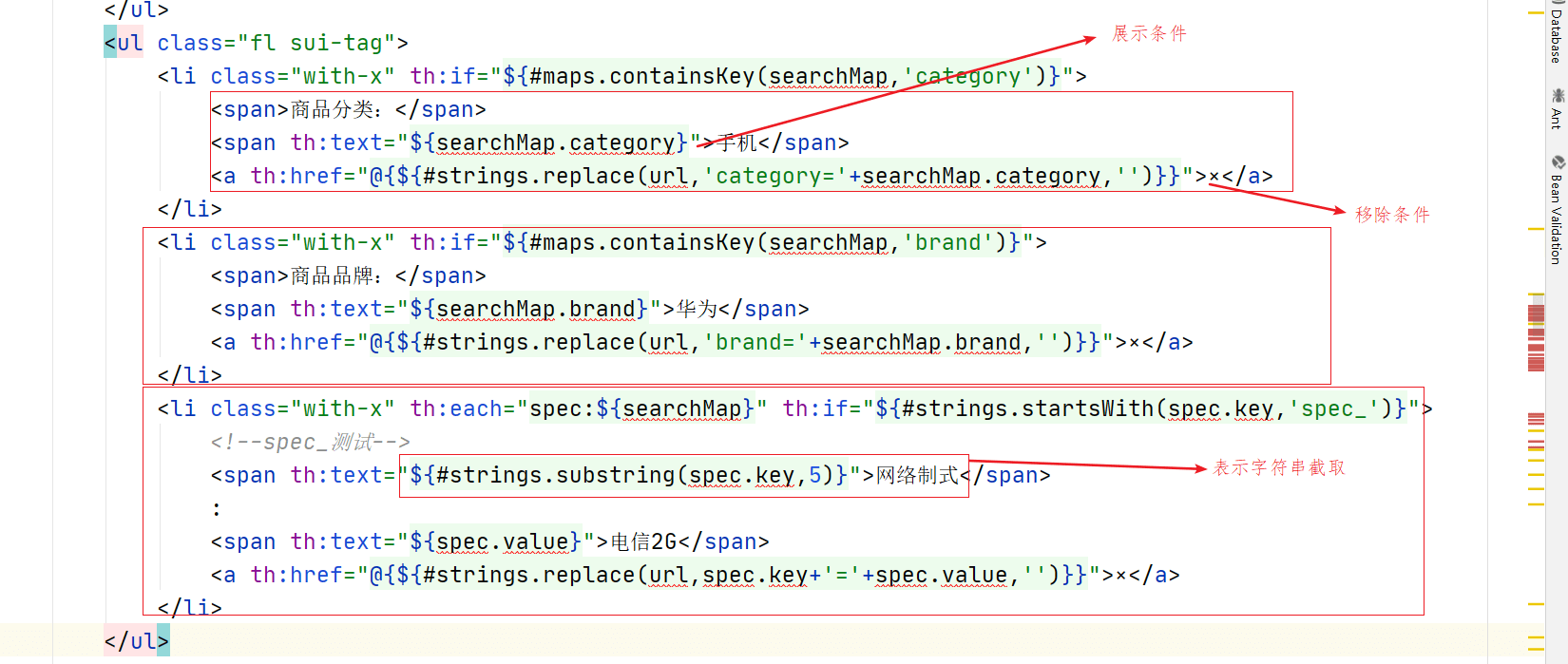
代码如下:
<ul class="fl sui-tag"><li class="with-x" th:if="${#maps.containsKey(searchMap,'category')}"><span>商品分类:</span><span th:text="${searchMap.category}">手机</span><a th:href="@{${#strings.replace(url,'category='+searchMap.category,'')}}">×</a></li><li class="with-x" th:if="${#maps.containsKey(searchMap,'brand')}"><span>商品品牌:</span><span th:text="${searchMap.brand}">华为</span><a th:href="@{${#strings.replace(url,'brand='+searchMap.brand,'')}}">×</a></li><li class="with-x" th:each="spec:${searchMap}" th:if="${#strings.startsWith(spec.key,'spec_')}"><!--spec_测试--><span th:text="${#strings.substring(spec.key,5)}">网络制式</span>:<span th:text="${spec.value}">电信2G</span><a th:href="@{${#strings.replace(url,spec.key+'='+spec.value,'')}}">×</a></li></ul>
解释:
${#strings.startsWith(spec.key,'spec_')}:表示以spec_开始的key${#strings.replace(url,'spec_','')}:表示将url中的spec_替换成空
4.6 排序(作业)

上图代码是排序代码,需要2个属性,sortRule:排序规则,ASC或者DESC,sortField:排序的域,前端每次只需要将这2个域的值传入到后台即可实现排序。
(1)后台组装排序URL
每次排序的时候恢复第1页查询,所以url地址我们需要重新拼接,每次切换排序的时候,不需要之前的排序信息,修改SkuController,代码如下: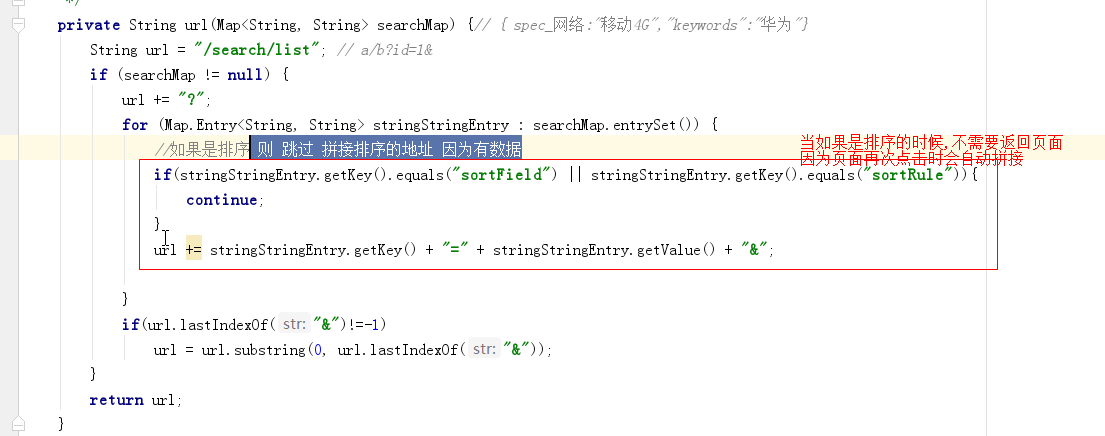
代码如下:
private String url(Map<String, String> searchMap) {// { spec_网络:"移动4G","keywords":"华为"}String url = "/search/list"; // a/b?id=1&if (searchMap != null) {url += "?";for (Map.Entry<String, String> stringStringEntry : searchMap.entrySet()) {//如果是排序 则 跳过 拼接排序的地址 因为有数据if(stringStringEntry.getKey().equals("sortField") || stringStringEntry.getKey().equals("sortRule")){continue;}url += stringStringEntry.getKey() + "=" + stringStringEntry.getValue() + "&";}if(url.lastIndexOf("&")!=-1)url = url.substring(0, url.lastIndexOf("&"));}return url;}
(2)前端排序实现
修改search.html,实现排序,代码如下:
这一块我们实现了价格排序,同学们课后去实现以下销量和新品排序。
4.7 分页
真实的分页应该像百度那样,如下图:


(1)分页工具类定义
在comm工程中添加Page分页对象,代码如下:
public class Page <T> implements Serializable{// 页数(第几页)private long currentpage;// 查询数据库里面对应的数据有多少条private long total;// 从数据库查处的总记录数// 每页查5条private int size;// 下页private int next;private List<T> list;// 最后一页private int last;private int lpage;private int rpage;//从哪条开始查private long start;//全局偏移量public int offsize = 2;public Page() {super();}/****** @param currentpage* @param total* @param pagesize*/public void setCurrentpage(long currentpage,long total,long pagesize) {//可以整除的情况下long pagecount = total/pagesize;//如果整除表示正好分N页,如果不能整除在N页的基础上+1页int totalPages = (int) (total%pagesize==0? total/pagesize : (total/pagesize)+1);//总页数this.last = totalPages;//判断当前页是否越界,如果越界,我们就查最后一页if(currentpage>totalPages){this.currentpage = totalPages;}else{this.currentpage=currentpage;}//计算startthis.start = (this.currentpage-1)*pagesize;}//上一页public long getUpper() {return currentpage>1? currentpage-1: currentpage;}//总共有多少页,即末页public void setLast(int last) {this.last = (int) (total%size==0? total/size : (total/size)+1);}/***** 带有偏移量设置的分页* @param total* @param currentpage* @param pagesize* @param offsize*/public Page(long total,int currentpage,int pagesize,int offsize) {this.offsize = offsize;initPage(total, currentpage, pagesize);}/****** @param total 总记录数* @param currentpage 当前页* @param pagesize 每页显示多少条*/public Page(long total,int currentpage,int pagesize) {initPage(total,currentpage,pagesize);}/***** 初始化分页* @param total* @param currentpage* @param pagesize*/public void initPage(long total,int currentpage,int pagesize){//总记录数this.total = total;//每页显示多少条this.size=pagesize;//计算当前页和数据库查询起始值以及总页数setCurrentpage(currentpage, total, pagesize);//分页计算int leftcount =this.offsize, //需要向上一页执行多少次rightcount =this.offsize;//起点页this.lpage =currentpage;//结束页this.rpage =currentpage;//2点判断this.lpage = currentpage-leftcount; //正常情况下的起点this.rpage = currentpage+rightcount; //正常情况下的终点//页差=总页数和结束页的差int topdiv = this.last-rpage; //判断是否大于最大页数/**** 起点页* 1、页差<0 起点页=起点页+页差值* 2、页差>=0 起点和终点判断*/this.lpage=topdiv<0? this.lpage+topdiv:this.lpage;/**** 结束页* 1、起点页<=0 结束页=|起点页|+1* 2、起点页>0 结束页*/this.rpage=this.lpage<=0? this.rpage+(this.lpage*-1)+1: this.rpage;/**** 当起点页<=0 让起点页为第一页* 否则不管*/this.lpage=this.lpage<=0? 1:this.lpage;/**** 如果结束页>总页数 结束页=总页数* 否则不管*/this.rpage=this.rpage>last? this.last:this.rpage;}public long getNext() {return currentpage<last? currentpage+1: last;}public void setNext(int next) {this.next = next;}public long getCurrentpage() {return currentpage;}public long getTotal() {return total;}public void setTotal(long total) {this.total = total;}public long getSize() {return size;}public void setSize(int size) {this.size = size;}public long getLast() {return last;}public long getLpage() {return lpage;}public void setLpage(int lpage) {this.lpage = lpage;}public long getRpage() {return rpage;}public void setRpage(int rpage) {this.rpage = rpage;}public long getStart() {return start;}public void setStart(long start) {this.start = start;}public void setCurrentpage(long currentpage) {this.currentpage = currentpage;}/*** @return the list*/public List<T> getList() {return list;}/*** @param list the list to set*/public void setList(List<T> list) {this.list = list;}}
(2)分页实现
由于这里需要获取分页信息,我们可以在changgou-service-search服务中修改搜索方法实现获取分页数据,修改com.changgou.search.service.impl.SkuServiceImpl的search方法,在return之前添加如下方法获取份额与数据:
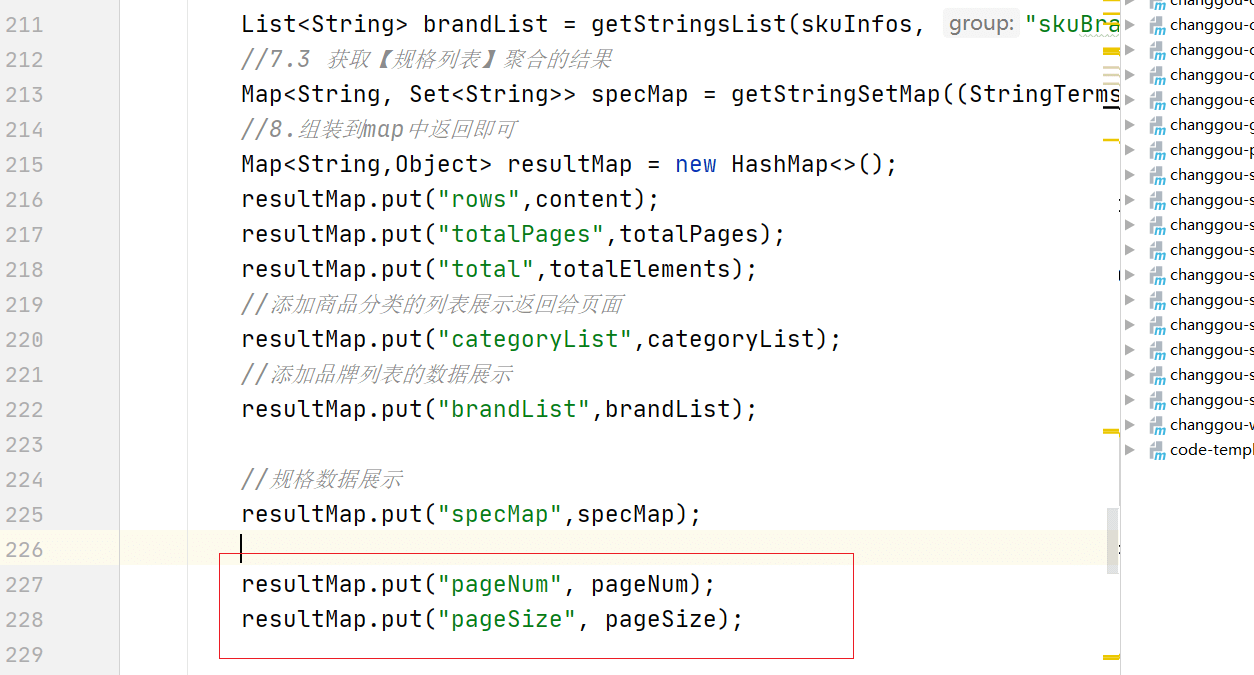
//分页数据保存//设置当前页码resultMap.put("pageNum", pageNum);resultMap.put("pageSize", pageSize);
修改SkuController,实现分页信息封装,代码如下:
(3)页面分页实现 修改search.html,实现分页查询,代码如下:
注意:每次如果搜条件发生变化都要从第1页查询,而点击下一页的时候,分页数据在页面给出,不需要在后台拼接的url中给出,所以在拼接url的时候,需要过滤掉分页参数,修改changgou-web-search的控制层com.changgou.search.controller.SkuController的url拼接方法,代码如下: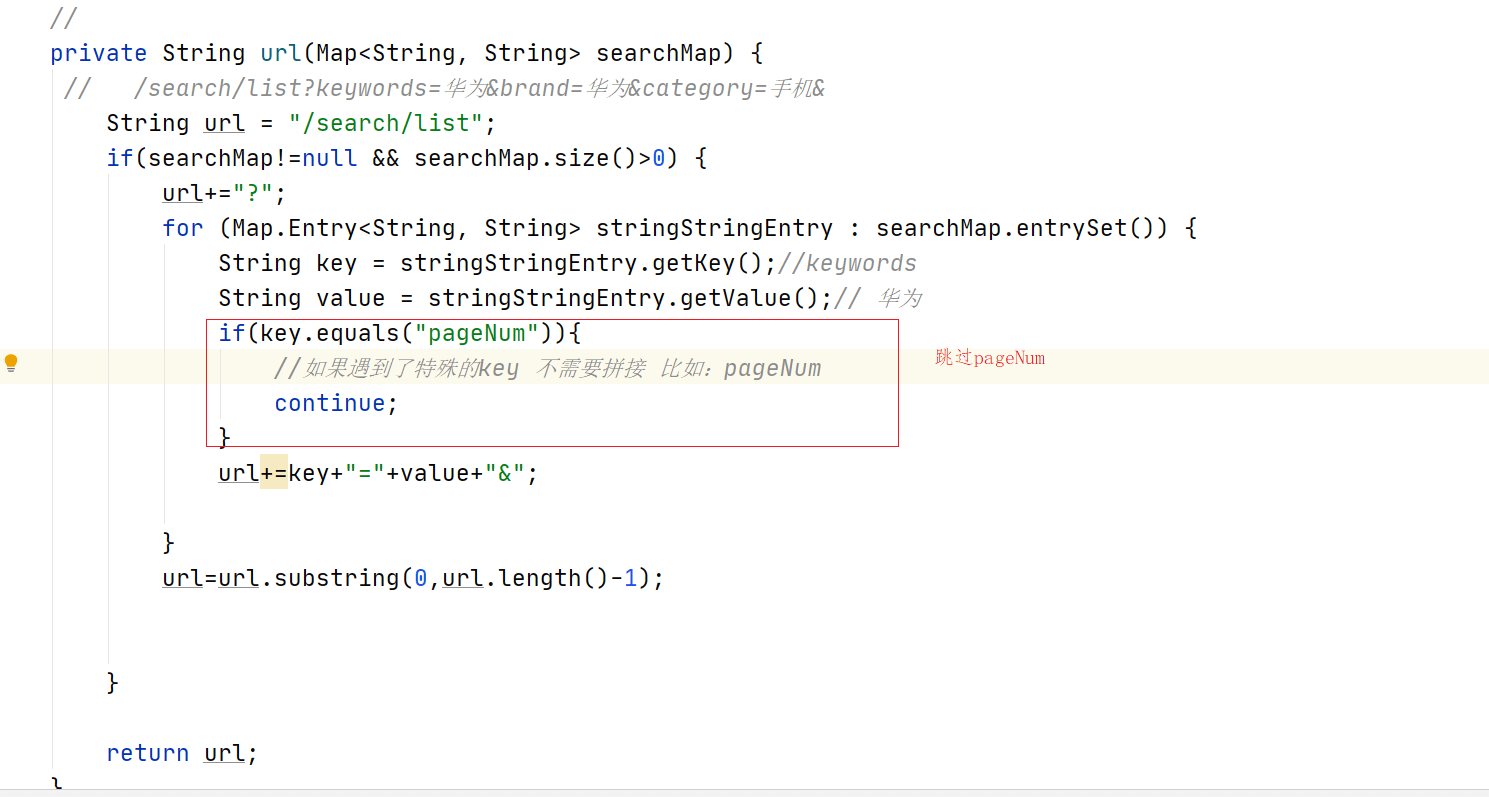
其中代码如下:
private String url(Map<String, String> searchMap) {String url = "/search/list";if (searchMap != null && searchMap.size() > 0) {url += "?";for (Map.Entry<String, String> stringStringEntry : searchMap.entrySet()) {String key = stringStringEntry.getKey();//keywordsString value = stringStringEntry.getValue();// 华为if (key.equals("pageNum")) {//如果遇到了特殊的key 不需要拼接 比如:pageNumcontinue;}url += key + "=" + value + "&";}url = url.substring(0, url.length() - 1);}return url;}
5.畅购商品详情页(作业)
5.1 需求分析
当系统审核完成商品,需要将商品详情页进行展示,那么采用静态页面生成的方式生成,并部署到高性能的web服务器中进行访问是比较合适的。所以,开发流程如下图所示: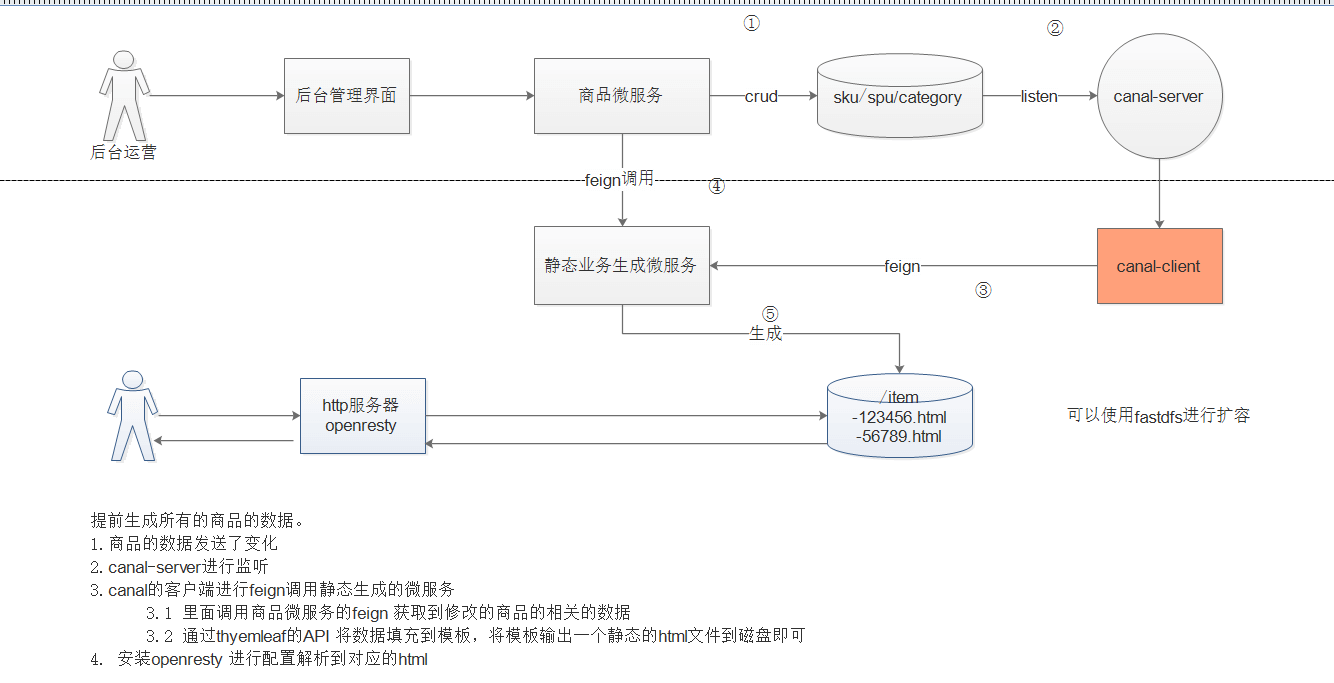
执行步骤解释:
- 系统管理员(商家运维人员)修改或者审核商品的时候,会触发canal监控数据
- canal微服务获取修改数据后,调用静态页微服务的方法进行生成静态页
- 静态页微服务只负责使用thymeleaf的模板技术生成静态页
5.2 商品静态化微服务创建
5.2.1 需求分析
该微服务只用于生成商品静态页,不做其他事情。5.2.2 搭建项目
(1)在changgou-web下创建一个名称为changgou-web-item的模块,如图:
(2)changgou-web-item中添加起步依赖,如下
(3)修改application.yml的配置<?xml version="1.0" encoding="UTF-8"?><project xmlns="http://maven.apache.org/POM/4.0.0"xmlns:xsi="http://www.w3.org/2001/XMLSchema-instance"xsi:schemaLocation="http://maven.apache.org/POM/4.0.0 http://maven.apache.org/xsd/maven-4.0.0.xsd"><parent><artifactId>changgou-web</artifactId><groupId>com.changgou</groupId><version>1.0-SNAPSHOT</version></parent><modelVersion>4.0.0</modelVersion><artifactId>changgou-web-item</artifactId><dependencies><!--api 模块--><dependency><groupId>com.changgou</groupId><artifactId>changgou-service-goods-api</artifactId><version>1.0-SNAPSHOT</version></dependency></dependencies></project>
(4)创建系统启动类server:port: 18085eureka:client:service-url:defaultZone: http://127.0.0.1:7001/eurekainstance:prefer-ip-address: truefeign:hystrix:enabled: truespring:thymeleaf:cache: falseapplication:name: itemmain:allow-bean-definition-overriding: true#rabbitmq:# host: 192.168.25.138# 生成静态页的位置pagepath: D:/project/workspace_changgou/changgou/changgou-parent/changgou-web/changgou-web-item/src/main/resources/templates/items
@SpringBootApplication@EnableEurekaClient@EnableFeignClients(basePackages = "com.changgou.goods.feign")public class ItemApplication {public static void main(String[] args) {SpringApplication.run(ItemApplication.class,args);}}
5.3 生成静态页
5.3.1 需求分析
页面发送请求,传递要生成的静态页的的商品的SpuID.后台controller 接收请求,调用thyemleaf的原生API生成商品静态页。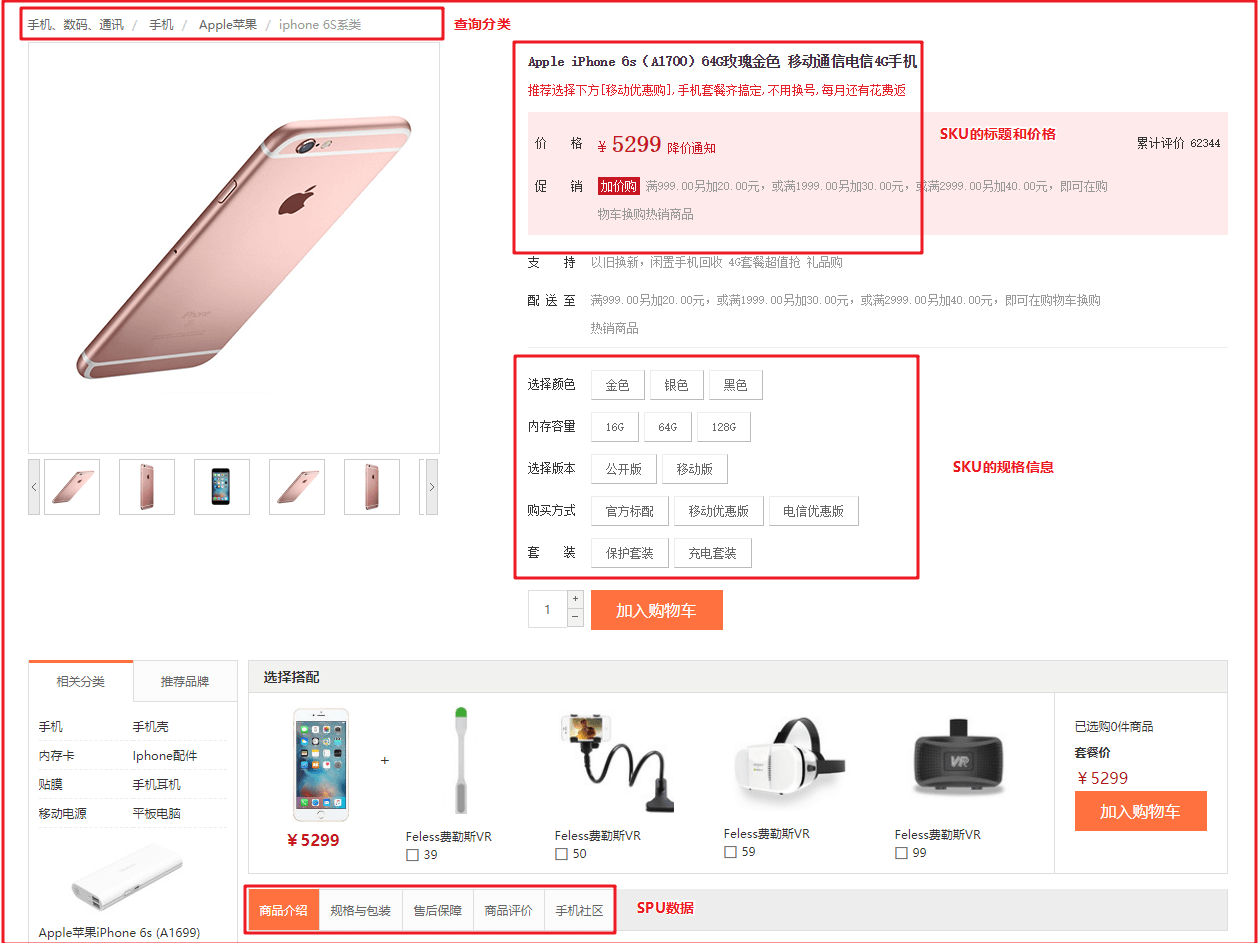
上图是要生成的商品详情页,从图片上可以看出需要查询SPU的3个分类作为面包屑显示,同时还需要查询SKU和SPU信息。5.3.2 Feign创建
一会儿需要查询SPU和SKU以及Category,所以我们需要先创建Feign,修改changgou-service-goods-api,添加CategoryFeign,并在CategoryFeign中添加根据ID查询分类数据,代码如下:
在changgou-service-goods-api,添加SkuFeign,并添加根据SpuID查询Sku集合,代码如下:/*** 获取分类的对象信息* @param id* @return*/@GetMapping("/{id}")public Result<Category> findById(@PathVariable(name = "id") Integer id);
在changgou-service-goods-api,添加SpuFeign,并添加根据SpuID查询Spu信息,代码如下:/*** 根据条件搜索* @param sku* @return*/@PostMapping(value = "/search" )public Result<List<Sku>> findList(@RequestBody(required = false) Sku sku);
/**** 根据SpuID查询Spu信息* @param id* @return*/@GetMapping("/{id}")public Result<Spu> findById(@PathVariable(name = "id") Long id);
5.3.3 静态页生成代码
(1)创建Controller
在changgou-web-item中创建com.changgou.item.controller.PageController用于接收请求,测试生成静态页
(2)创建service@RestController@RequestMapping("/page")public class PageController {@Autowiredprivate PageService pageService;/*** 生成静态页面* @param id* @return*/@RequestMapping("/createHtml/{id}")public Result createHtml(@PathVariable(name="id") Long id){pageService.createPageHtml(id);return new Result(true, StatusCode.OK,"ok");}}
接口:
实现类:public interface PageService {/*** 根据商品的ID 生成静态页* @param spuId*/public void createPageHtml(Long spuId) ;}
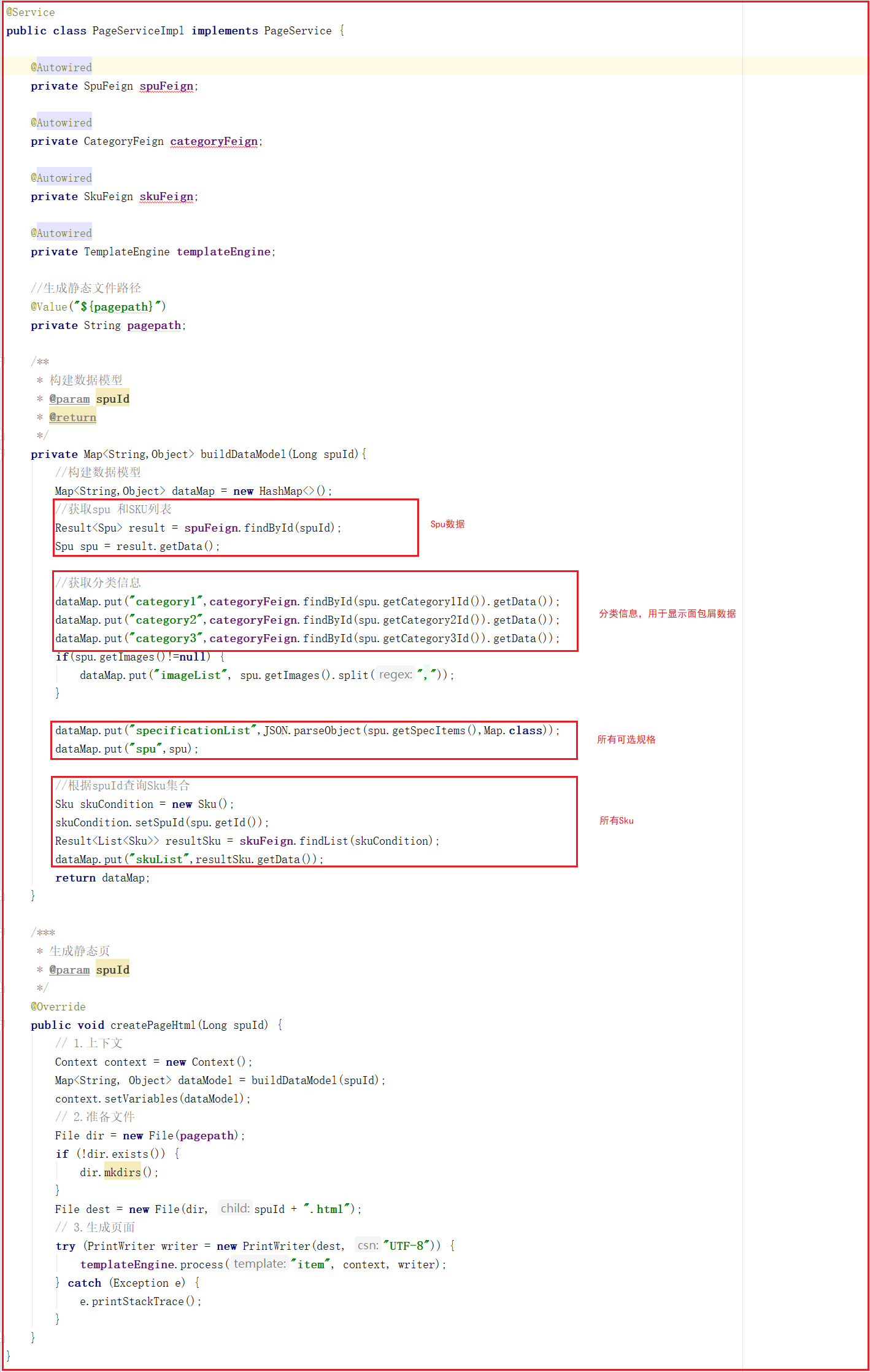
上图代码如下:@Servicepublic class PageServiceImpl implements PageService {@Autowiredprivate SpuFeign spuFeign;@Autowiredprivate CategoryFeign categoryFeign;@Autowiredprivate SkuFeign skuFeign;@Autowiredprivate TemplateEngine templateEngine;//生成静态文件路径@Value("${pagepath}")private String pagepath;/*** 构建数据模型* @param spuId* @return*/private Map<String,Object> buildDataModel(Long spuId){//构建数据模型Map<String,Object> dataMap = new HashMap<>();//获取spu 和SKU列表Result<Spu> result = spuFeign.findById(spuId);Spu spu = result.getData();//获取分类信息dataMap.put("category1",categoryFeign.findById(spu.getCategory1Id()).getData());dataMap.put("category2",categoryFeign.findById(spu.getCategory2Id()).getData());dataMap.put("category3",categoryFeign.findById(spu.getCategory3Id()).getData());if(spu.getImages()!=null) {dataMap.put("imageList", spu.getImages().split(","));}dataMap.put("specificationList",JSON.parseObject(spu.getSpecItems(),Map.class));dataMap.put("spu",spu);//根据spuId查询Sku集合Sku skuCondition = new Sku();skuCondition.setSpuId(spu.getId());Result<List<Sku>> resultSku = skuFeign.findList(skuCondition);dataMap.put("skuList",resultSku.getData());return dataMap;}/**** 生成静态页* @param spuId*/@Overridepublic void createPageHtml(Long spuId) {// 1.上下文Context context = new Context();Map<String, Object> dataModel = buildDataModel(spuId);context.setVariables(dataModel);// 2.准备文件File dir = new File(pagepath);if (!dir.exists()) {dir.mkdirs();}File dest = new File(dir, spuId + ".html");// 3.生成页面try (PrintWriter writer = new PrintWriter(dest, "UTF-8")) {templateEngine.process("item", context, writer);} catch (Exception e) {e.printStackTrace();}}}
5.2.4 模板填充
(1)面包屑数据
修改item.html,填充三个分类数据作为面包屑,代码如下:
(2)商品图片
修改item.html,将商品图片信息输出,在真实工作中需要做空判断,代码如下: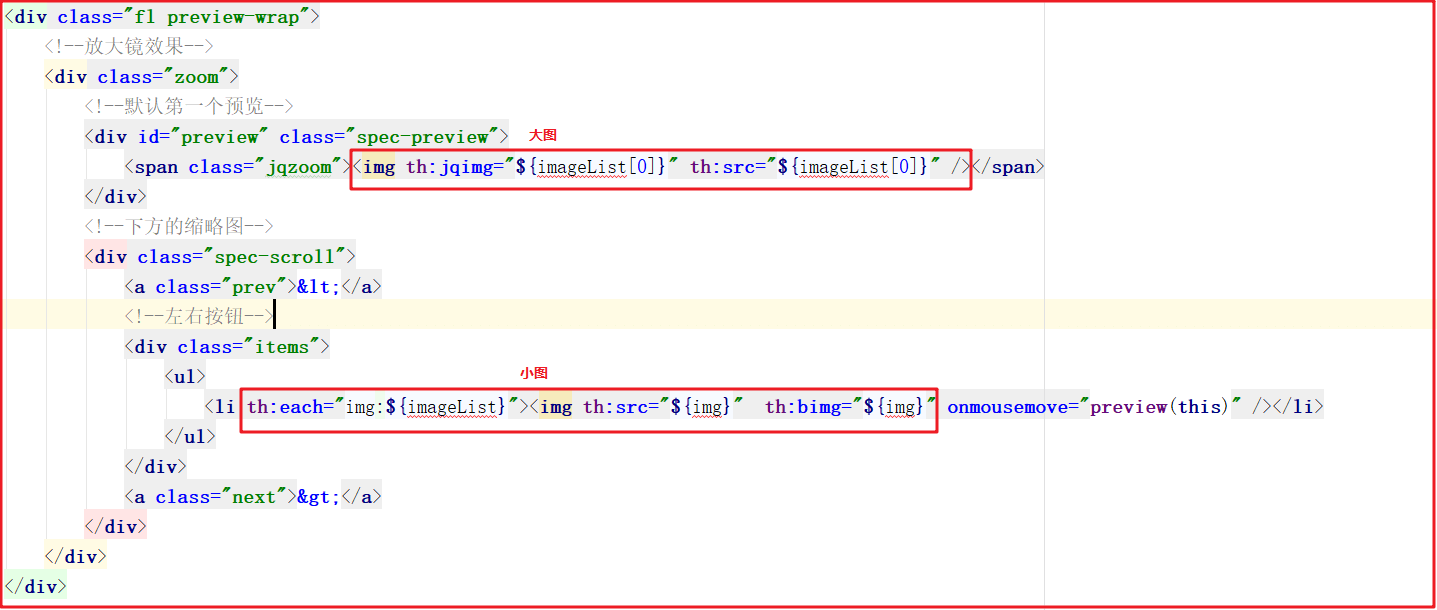
(3)规格输出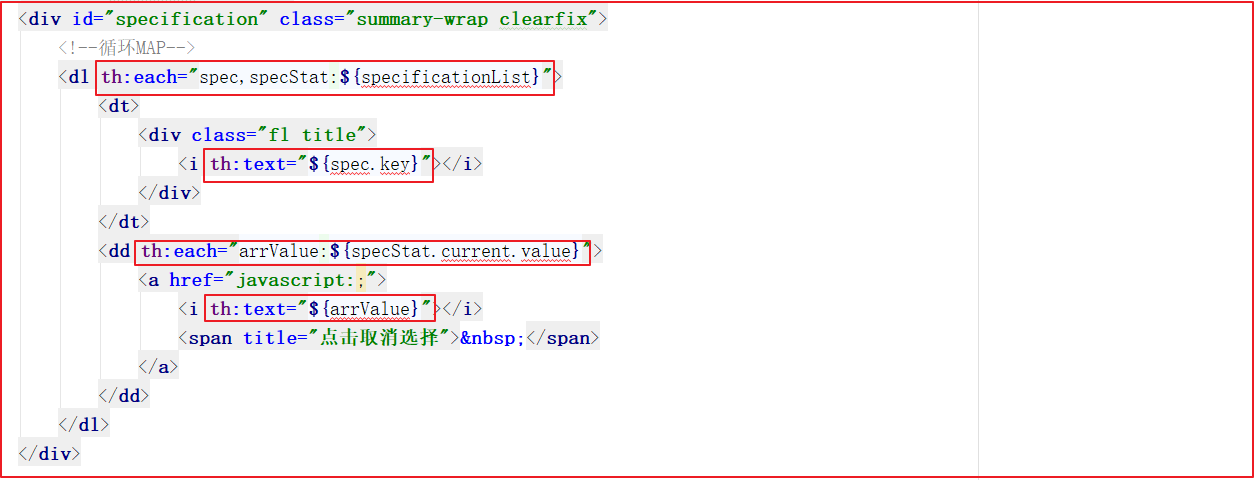
(4)默认SKU显示
静态页生成后,需要显示默认的Sku,我们这里默认显示第1个Sku即可,这里可以结合着Vue一起实现。可以先定义一个集合,再定义一个spec和sku,用来存储当前选中的Sku信息和Sku的规格,代码如下: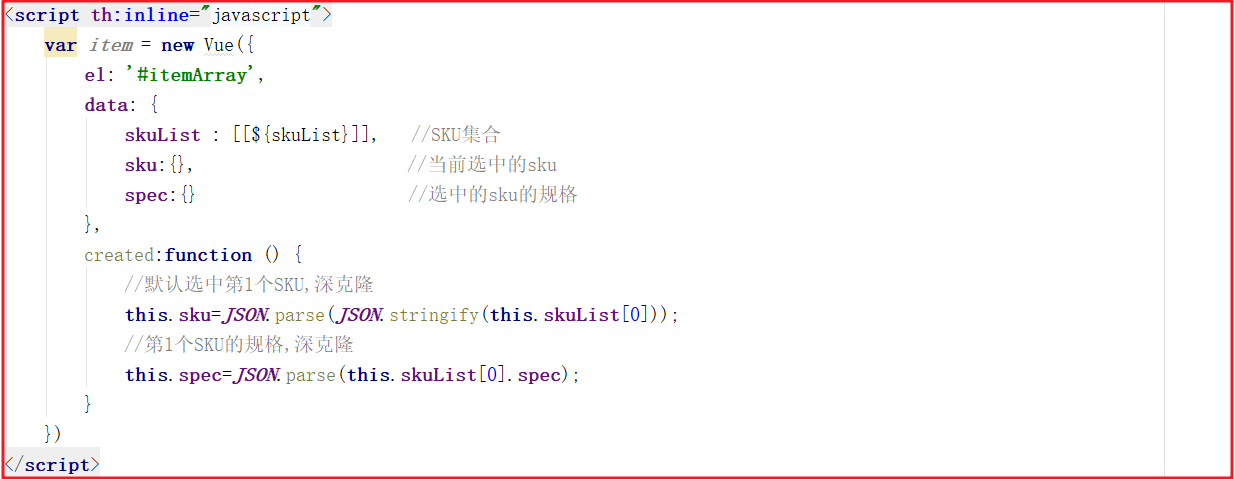
页面显示默认的Sku信息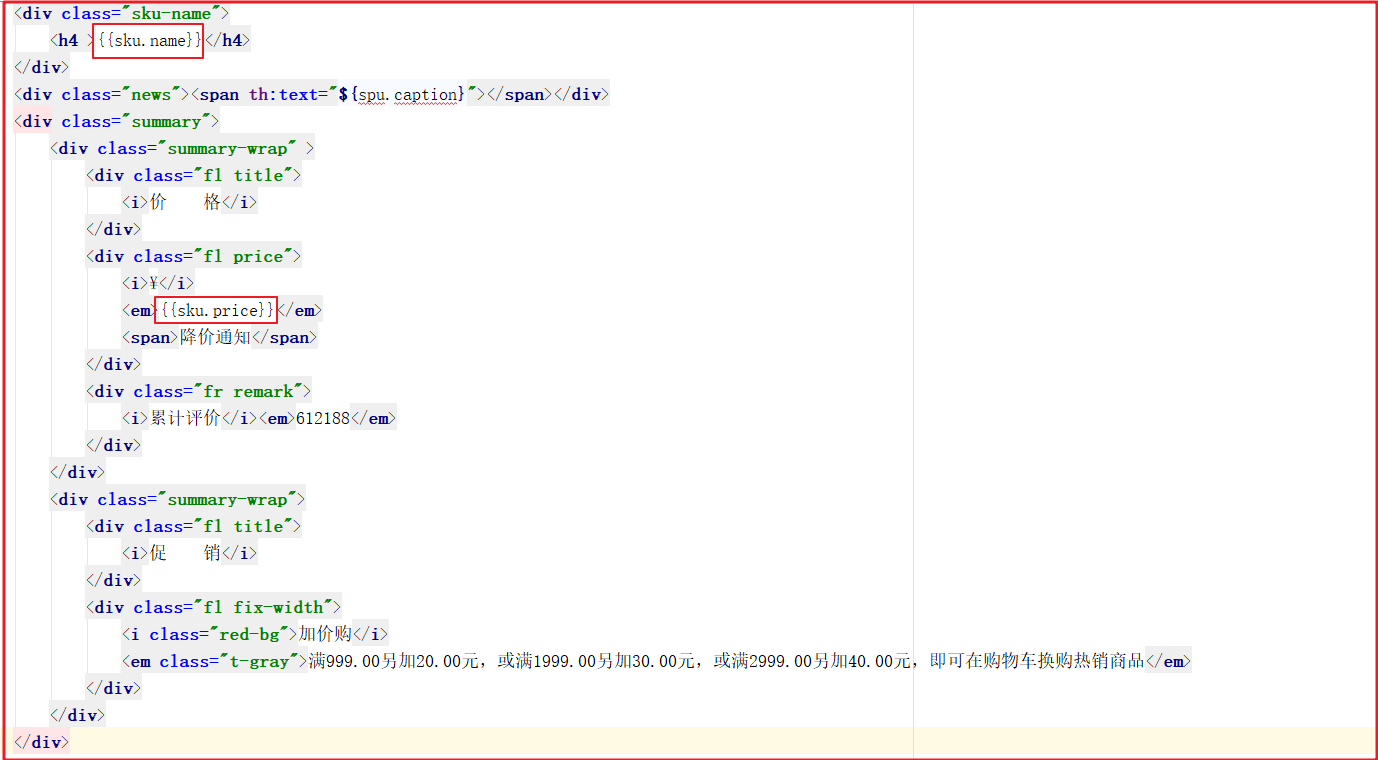
(5)记录选中的Sku
在当前Spu的所有Sku中spec值是唯一的,我们可以根据spec来判断用户选中的是哪个Sku,我们可以在Vue中添加代码来实现,代码如下:
添加规格点击事件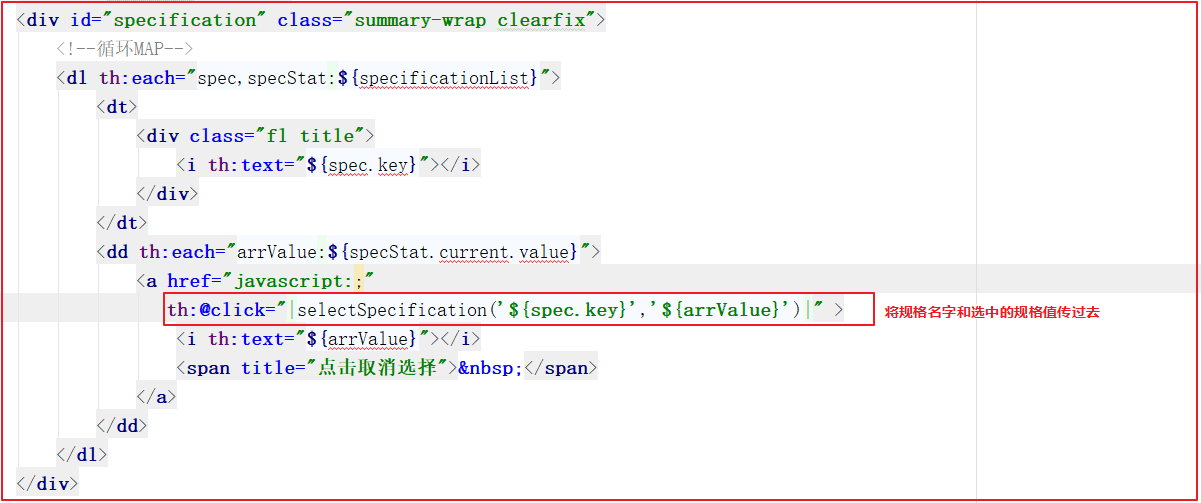
(6)样式切换
点击不同规格后,实现样式选中,我们可以根据每个规格判断该规格是否在当前选中的Sku规格中,如果在,则返回true添加selected样式,否则返回false不添加selected样式。
Vue添加代码: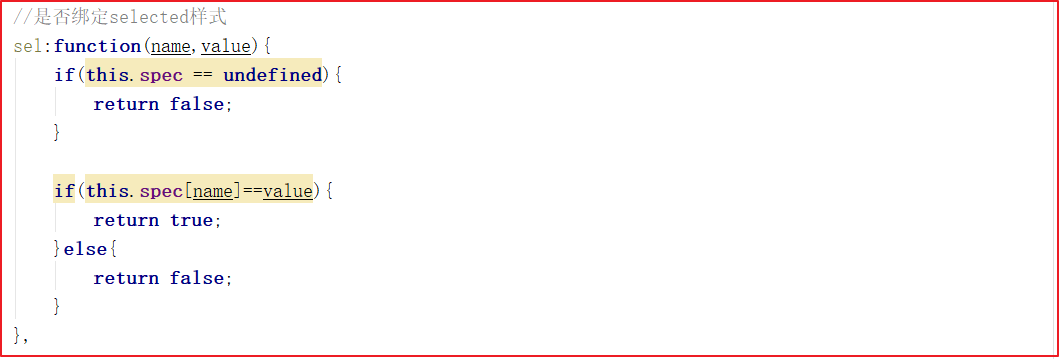
页面添加样式绑定,代码如下: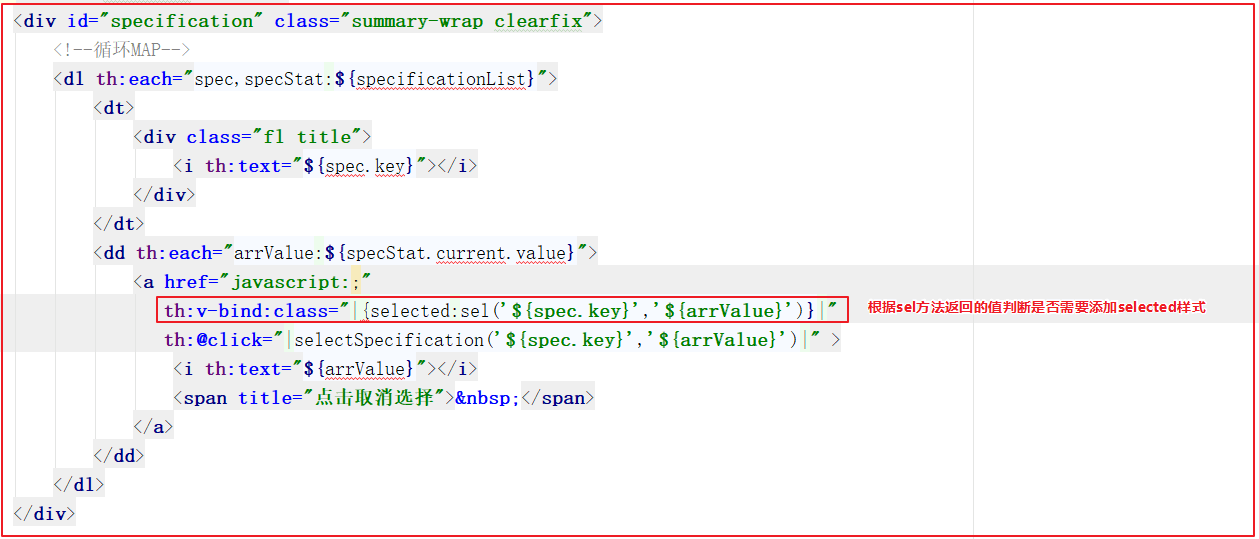
5.2.5 静态资源过滤
生成的静态页我们可以先放到changgou-web-item工程中,后面项目实战的时候可以挪出来放到Nginx指定发布目录。一会儿我们将生成的静态页放到resources/templates/items目录下,所以请求该目录下的静态页需要直接到该目录查找即可。
我们创建一个EnableMvcConfig类,开启静态资源过滤,代码如下:@ControllerAdvice@Configurationpublic class EnableMvcConfig implements WebMvcConfigurer{/**** 静态资源放行* @param registry*/@Overridepublic void addResourceHandlers(ResourceHandlerRegistry registry) {registry.addResourceHandler("/items/**").addResourceLocations("classpath:/templates/items/");}}
5.4.6 启动测试
启动eurekea服务端
启动商品微服务
启动静态化微服务 changgou-web-item
将静态资源导入到changgou-web-item中,如下图: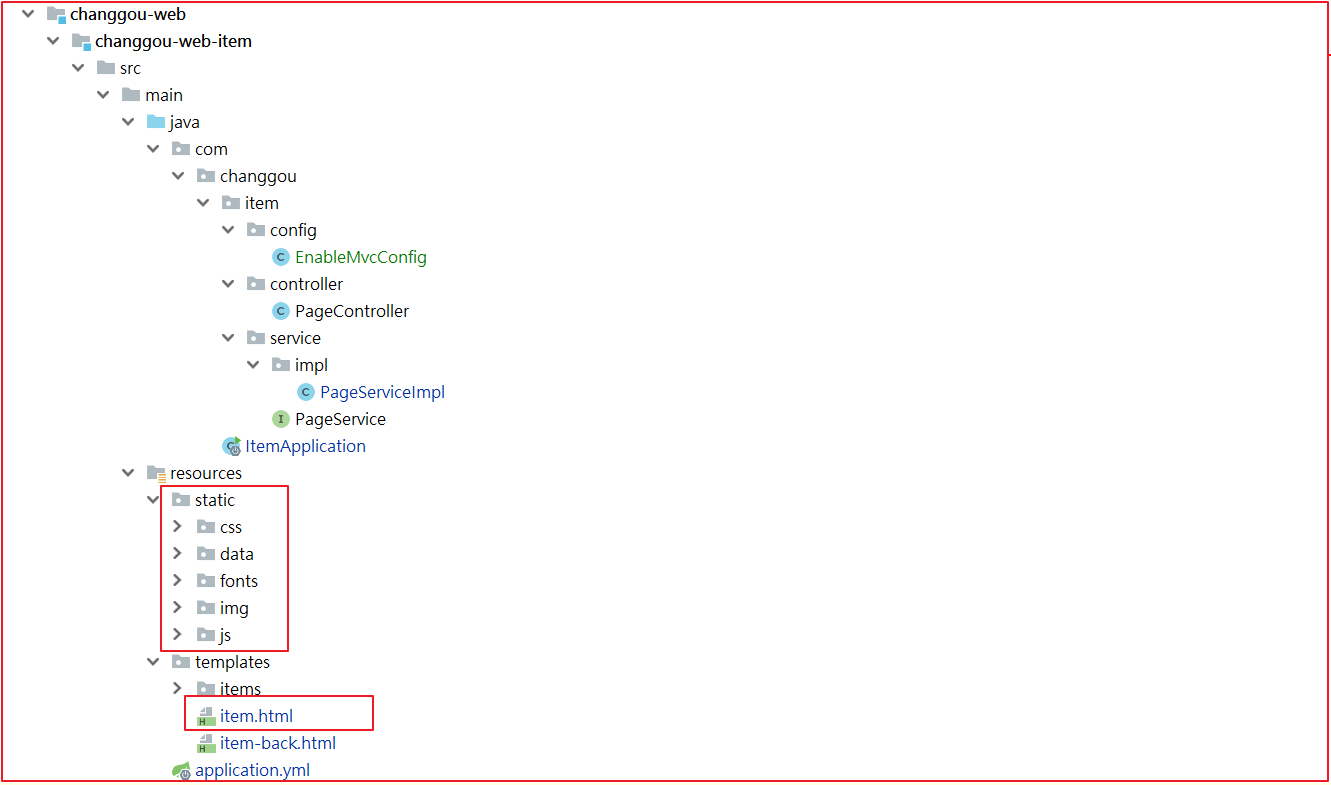
生成静态页地址http://localhost:18085/page/createHtml/1087918019151269888
静态页生成后访问地址http://localhost:18085/items/1087918019151269888.html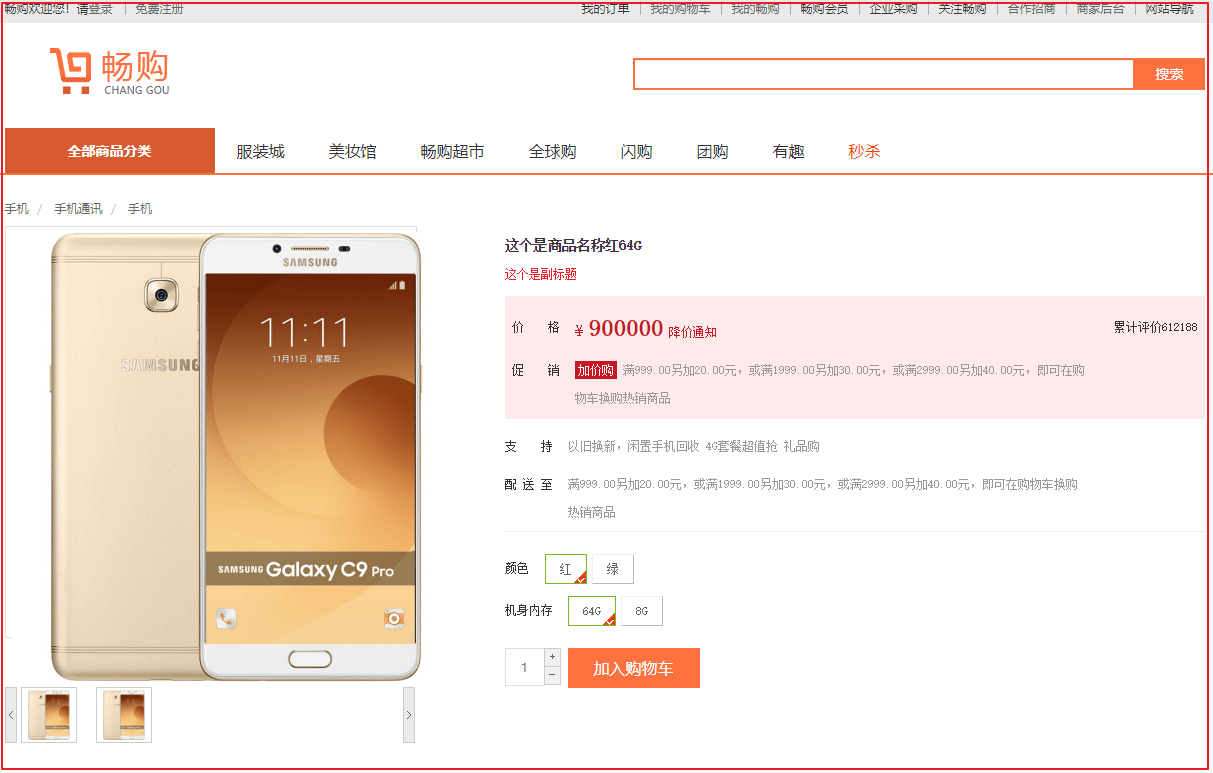
6 canal监听生成静态页

如上图详情页的解决方案. 监听到数据的变化,直接调用feign 生成静态页即可.6.1 需求分析
当商品微服务审核商品之后,应当发送消息,这里采用了Canal监控数据变化,数据变化后,调用feign实现生成静态页6.2 Feign创建
在changgou-service-api中创建changgou-web-item-api,该工程中主要创建changgou-web-item的对外依赖抽取信息。
(1)Feign创建
在changgou-web-item-api中创建com.changgou.item.feign.PageFeign,代码如下:
(2)pom.xml依赖@FeignClient(name="item")@RequestMapping("/page")public interface PageFeign {/**** 根据SpuID生成静态页* @param id* @return*/@RequestMapping("/createHtml/{id}")Result createHtml(@PathVariable(name="id") Long id);}
修改changgou-service-canal工程的pom.xml,引入如下依赖:
(3)修改changgou-service-canal工程中的启动类<!--静态页API 服务--><dependency><groupId>com.changgou</groupId><artifactId>changgou-web-item-api</artifactId><version>1.0-SNAPSHOT</version></dependency>

@SpringBootApplication(exclude = DataSourceAutoConfiguration.class)@EnableEurekaClient@EnableCanalClient // 启用canal@EnableFeignClients(basePackages = {"com.changgou.content.feign","com.changgou.item.feign"})public class CanalApplication {public static void main(String[] args) {SpringApplication.run(CanalApplication.class, args);}}
6.3 canal监听数据变化
监听类中,监听商品数据库的tb_spu的数据变化,当数据变化的时候生成静态页或者删除静态页
在原来的监听类中添加如下代码即可,
整体的页面代码如下图所示已经实现:@Autowiredprivate PageFeign pageFeign;@ListenPoint(destination = "example",schema = "changgou_goods",table = {"tb_spu"},eventType = {CanalEntry.EventType.UPDATE, CanalEntry.EventType.INSERT, CanalEntry.EventType.DELETE})public void onEventCustomSpu(CanalEntry.EventType eventType, CanalEntry.RowData rowData) {//判断操作类型if (eventType == CanalEntry.EventType.DELETE) {String spuId = "";List<CanalEntry.Column> beforeColumnsList = rowData.getBeforeColumnsList();for (CanalEntry.Column column : beforeColumnsList) {if (column.getName().equals("id")) {spuId = column.getValue();//spuidbreak;}}//todo 删除静态页}else{//新增 或者 更新List<CanalEntry.Column> afterColumnsList = rowData.getAfterColumnsList();String spuId = "";for (CanalEntry.Column column : afterColumnsList) {if (column.getName().equals("id")) {spuId = column.getValue();break;}}//更新 生成静态页pageFeign.createHtml(Long.valueOf(spuId));}}
